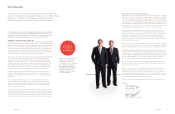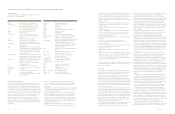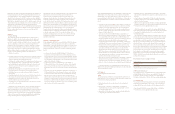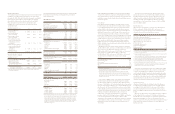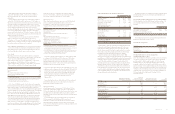OG&E 2014 Annual Report Download - page 13
Download and view the complete annual report
Please find page 13 of the 2014 OG&E annual report below. You can navigate through the pages in the report by either clicking on the pages listed below, or by using the keyword search tool below to find specific information within the annual report.
22 OGE Energy Corp. OGE Energy Corp. 23
Contractual Obligations
The following table summarizes the Company’s contractual obligations
at December 31, 2014. See the Company’s Consolidated Statements
of Capitalization and Note 14 of Notes to Consolidated Financial
Statements for additional information.
(In millions) 2015 2016-2017 2018-2019 After 2019 Total
Maturities of long-term debt (A) $ 0.2 $ 335.3 $ 500.2 $1,929.9 $ 2,765.6
Operating lease obligations
Railcars 4.5 29.7 — — 34.2
Wind farm land leases 2.1 4.5 4.8 46.4 57.8
OGE Energy noncancellable operating lease 0.8 1.6 0.7 — 3.1
Total operating lease obligations 7.4 35.8 5.5 46.4 95.1
Other purchase obligations and commitments
Cogeneration capacity and fixed operation and maintenance payments 85.2 164.0 148.4 167.4 565.0
Expected cogeneration energy payments 74.4 159.7 174.8 235.9 644.8
Minimum fuel purchase commitments 389.3 290.2 — — 679.5
Expected wind purchase commitments 58.4 119.6 117.5 308.6 604.1
Long-term service agreement commitments 2.5 5.3 46.9 142.3 197.0
Environmental compliance plan expenditures 66.5 255.7 54.0 — 376.2
Total other purchase obligations and commitments 676.3 994.5 541.6 854.2 3,066.6
Total contractual obligations 683.9 1,365.6 1,047.3 2,830.5 5,927.3
Amounts recoverable through fuel adjustment clause (B) (526.6) (599.2) (292.3) (544.5) (1,962.6)
Total contractual obligations, net $ 157.3 $ 766.4 $ 755.0 $2,286.0 $ 3,964.7
(A) Maturities of the Company’s long-term debt during the next five years consist of $0.2 million, $110.2 million, $225.1 million, $250.1 million and $250.1 million in years 2015, 2016,
2017, 2018 and 2019, respectively.
(B) Includes expected recoveries of costs incurred for OG&E’s railcar operating lease obligations, OG&E’s expected cogeneration energy payments, OG&E’s minimum fuel purchase
commitments and OG&E’s expected wind purchase commitments.
OG&E also has 440 MWs of QF contracts to meet its current and
future expected customer needs. OG&E will continue reviewing all of
the supply alternatives to these QF contracts that minimize the total
cost of generation to its customers, including exercising its options
(if applicable) to extend these QF contracts at pre-determined rates.
The actual cost of fuel used in electric generation (which includes
the operating lease obligations for OG&E’s railcar leases shown above)
and certain purchased power costs are passed through to OG&E’s
customers through fuel adjustment clauses. Accordingly, while the cost
of fuel related to operating leases and the vast majority of minimum
fuel purchase commitments of OG&E noted above may increase
capital requirements, such costs are recoverable through fuel
adjustment clauses and have little, if any, impact on net capital
requirements and future contractual obligations. The fuel adjustment
clauses are subject to periodic review by the OCC, the APSC and
the FERC.
Pension and Postretirement Benefit Plans
At December 31, 2014, 33.0 percent of the Pension Plan investments
were in listed common stocks with the balance primarily invested in
U.S Government securities, bonds, debentures and notes, a
commingled fund and a common collective trust as presented in
Note 12 of Notes to Consolidated Financial Statements. In 2014, asset
returns on the Pension Plan were 12.8 percent due to the gains in fixed
income and equity investments. During the same time, corporate bond
yields, which are used in determining the discount rate for future
pension obligations, decreased. During 2013, OGE Energy made
contributions to its Pension Plan of $35 million to help ensure that the
Pension Plan maintains an adequate funded status. The level of
funding is dependent on returns on plan assets and future discount
rates. During 2014, OGE Energy did not make any contributions to its
Pension Plan. OGE Energy has not yet determined whether it will need
to make any contributions to the Pension Plan in 2015. OGE Energy
could be required to make additional contributions if the value of its
pension trust and postretirement benefit plan trust assets are adversely
impacted by a major market disruption in the future.
The following table presents the status of the Company’s Pension
Plan, the Restoration of Retirement Income Plan and the
postretirement benefit plans at December 31, 2014 and 2013. These
amounts have been recorded in Accrued Benefit Obligations with the
offset in Accumulated Other Comprehensive Loss (except OG&E’s
portion which is recorded as a regulatory asset as discussed in Note 1
of Notes to Consolidated Financial Statements) in the Company’s
Consolidated Balance Sheet. The amounts in Accumulated Other
Comprehensive Loss and those recorded as a regulatory asset
represent a net periodic benefit cost to be recognized in the
Consolidated Statements of Income in future periods.
Restoration of
Pension Plan Retirement Income Plan Postretirement Benefit Plans
December 31 (In millions) 2014 2013 2014 2013 2014 2013
Benefit obligations $725.0 $658.1 $ 19.7 $ 14.0 $ 280.9 $ 258.2
Fair value of plan assets 679.8 654.9 — — 59.6 61.4
Funded status at end of year $ (45.2) $ (3.2) $(19.7) $(14.0) $(221.3) $(196.8)
In accordance with ASC Topic 715, “Compensation - Retirement
Benefits,” a one-time settlement charge is required to be recorded by
an organization when lump sum payments or other settlements that
relieve the organization from the responsibility for the pension benefit
obligation during a plan year exceed the service cost and interest cost
components of the organization’s net periodic pension cost. During
2013, the Company experienced an increase in both the number of
employees electing to retire and the amount of lump sum payments
to be paid to such employees upon retirement. As a result, and based
in part on the Company’s historical experience regarding eligible
employees who elect to retire in the last quarter of a particular year,
the Company recorded pension settlement charges of $22.4 million in
the fourth quarter of 2013, of which $17.0 million related to OG&E’s
Oklahoma jurisdiction and has been included in the pension tracker.
The pension settlement charge did not require a cash outlay by the
Company and did not increase the Company’s total pension expense
over time, as the charges were an acceleration of costs that otherwise
would be recognized as pension expense in future periods.
Common Stock Dividends
The Company’s dividend policy is reviewed by the Board of Directors
at least annually and is based on numerous factors, including
management’s estimation of the long-term earnings power of its
businesses. The Company’s financial objective includes dividend
increases of approximately 10 percent annually through 2019.
The targeted annual dividend increase has been determined after
consideration of numerous factors, including the largely retail
composition of the Company’s shareholder base, the Company’s
financial position, the Company’s growth targets and the composition
of the Company’s assets and investment opportunities. At the
Company’s September 2014 Board meeting, the Board of Directors
approved management’s recommendation of an 11 percent increase in
the quarterly dividend rate to $0.25000 per share from $0.22500 per
share effective in October 2014.
Security Ratings
Standard
Moody’s & Poor’s
Investors Ratings Fitch
Services Services Ratings
OG&E Senior Notes A1 A- A+
OGE Energy Senior Notes A3 BBB+ A-
OGE Energy Commercial Paper P2 A2 F2
Access to reasonably priced capital is dependent in part on credit
and security ratings. Generally, lower ratings lead to higher financing
costs. Pricing grids associated with the Company’s credit facilities
could cause annual fees and borrowing rates to increase if an adverse
rating impact occurs. The impact of any future downgrade could include
an increase in the costs of the Company’s short-term borrowings,
but a reduction in the Company’s credit ratings would not result in
any defaults or accelerations. Any future downgrade could also lead
to higher long-term borrowing costs and, if below investment grade,
would require the Company to post collateral or letters of credit.
On November 8, 2013, Moody’s Investors Services placed the credit
ratings of OGE Energy and OG&E on review for possible upgrade. On
January 31, 2014, Moody’s upgraded the long-term senior unsecured
rating of OGE Energy to A3 and OG&E to A1 primarily due to their
more favorable view of the relative credit supportiveness of the
U.S. regulatory environment. All other security ratings from Moody’s
remain unchanged.
A security rating is not a recommendation to buy, sell or hold
securities. Such rating may be subject to revision or withdrawal at any
time by the credit rating agency and each rating should be evaluated
independently of any other rating.
Future financing requirements may be dependent, to varying
degrees, upon numerous factors such as general economic conditions,
abnormal weather, load growth, commodity prices, acquisitions of other
businesses and/or development of projects, actions by rating agencies,
inflation, changes in environmental laws or regulations, rate increases
or decreases allowed by regulatory agencies, new legislation and
market entry of competing electric power generators.
2014 Capital Requirements,
Sources of Financing and Financing Activities
Total capital requirements, consisting of capital expenditures and
maturities of long-term debt, were $809.5 million and contractual
obligations, net of recoveries through fuel adjustment clauses, were
$88.2 million resulting in total net capital requirements and contractual
obligations of $897.7 million in 2014, of which $31.5 million was to
comply with environmental regulations. This compares to net capital
requirements of $990.7 million and net contractual obligations of
$96.4 million totaling $1,087.1 million in 2013, of which $42.0 million
was to comply with environmental regulations.
In 2014, the Company’s sources of capital were cash generated from
operations, proceeds from the issuance of short- and long - term debt,
proceeds from the sales of common stock to the public through the
Company’s Automatic Dividend Reinvestment and Stock Purchase


